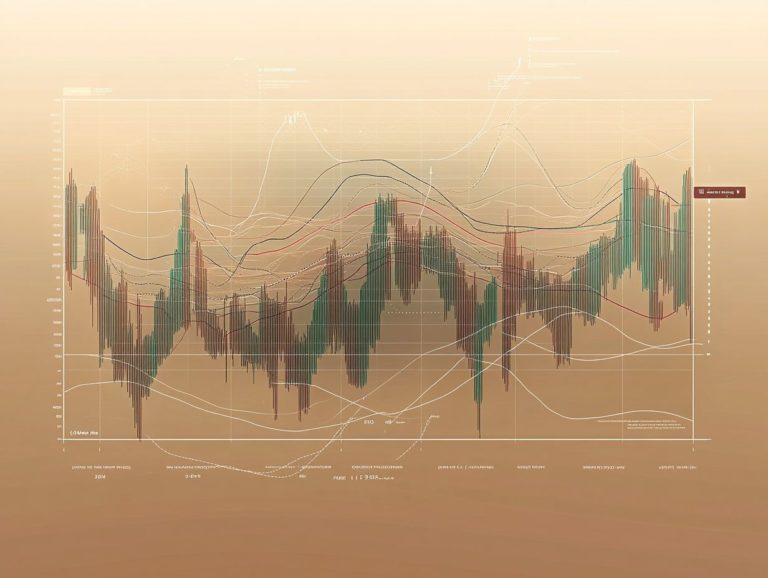The Evolution of Technical Analysis in Trading
Technical analysis has emerged as an indispensable tool for you as a trader, helping you navigate the intricate landscape of financial markets.
This article delves into its rich history, tracing its origins and evolution through the ages. You’ll explore key principles such as price action, market trends, and support and resistance levels.
Various tools and indicators that traders rely on will be examined, along with their practical applications in your trading strategies.
Looking ahead, advancements will shape the next era of trading. Dive in now to uncover the exciting nuances of technical analysis and understand its vital role in making informed trading decisions.
Contents
- Key Takeaways:
- Definition and Purpose
- The History of Technical Analysis
- Key Principles of Technical Analysis
- Tools and Indicators Used in Technical Analysis
- Applications of Technical Analysis in Trading
- The Future of Technical Analysis
- Frequently Asked Questions
- Curious about what technical analysis is?
- How has technical analysis evolved over time?
- What are some major milestones in the evolution of technical analysis?
- Why is technical analysis important in trading?
- What are some common technical analysis tools?
- How has technology impacted technical analysis in trading?
Key Takeaways:
- Technical analysis helps predict future price movements by analyzing past data.
- It originated in the 17th century and has evolved with new tools.
- Traders use it to make informed decisions, enhanced by modern innovations.
Definition and Purpose
Technical analysis is a method employed in financial markets to assess and predict price movements within the stock market. It analyzes market data and historical price trends. This helps uncover profitable investment opportunities through a range of trading signals and price patterns.
This approach gives you the power to make informed decisions about when to buy or sell assets. By grasping the emotions that drive traders, you can harness this analysis to formulate strategies that resonate with prevailing market sentiment.
The History of Technical Analysis
The history of technical analysis takes you back to the late 19th century, where Charles Dow, co-founder of the Dow Jones Industrial Index, established the groundwork for what would evolve into Dow Theory. This foundational theory was enriched by notable figures like William P. Hamilton, Robert Rhea, Edson Gould, and John Magee.
Their insightful writings and financial papers played a crucial role in shaping the principles of technical analysis as you understand them today.
Origins and Evolution
The origins of technical analysis can be traced back to the innovative practices of Japanese rice traders in the 17th century. These traders developed candlestick patterns to predict price movements, leveraging historical data and the emotional behavior of their peers. This early form of market analysis laid the groundwork for the more structured methodologies that would evolve over time, shaped by influential thinkers like Joseph de la Vega and the trading practices observed in the Amsterdam market.
You can see how these early traders grasped that market sentiment could dramatically impact prices, prompting them to meticulously observe price trends and formations. Candlestick patterns like dojis, hammers, and engulfing patterns encapsulate this understanding, vividly illustrating the dynamic interaction between buyers and sellers.
The rich history of these techniques not only underscores their enduring relevance but also reveals how modern analysts continue to rely on these visual cues. By doing so, they gauge market sentiment, predict potential reversals, and identify continuation patterns, effectively bridging the wisdom of the past with contemporary trading strategies.
Key Principles of Technical Analysis
The key principles of technical analysis center on your grasp of price action, market trends, and the identification of support and resistance levels elements that are essential for making informed trading decisions.
By employing various technical indicators, such as moving averages and momentum oscillators, you can analyze historical price data to anticipate future price movements and seize market opportunities.
Price Action and Market Trends
Price action describes the movement of a security s price over time. Analyzing it is essential for recognizing market trends, whether they are bullish (indicating that prices are expected to rise) or bearish (indicating that prices are expected to fall). You ll want to closely look at these price movements to identify stock trends. This will help you gauge overall market sentiment and make timely decisions based on the patterns you observe.
This analysis typically employs techniques like candlestick charting, where you look for specific formations that signal potential reversals or continuations in trends. For example, spotting an ascending triangle pattern might indicate a bullish scenario, suggesting it s time for you to consider initiating long positions. In contrast, a descending triangle could signal a bearish trend, prompting you to close those long positions or even initiate short ones.
By diligently observing these price trends, you can craft smart strategies that resonate with market movements. Understanding these dynamics not only aids in forecasting price movements but also equips you to manage risk effectively.
Support and Resistance Levels
Support and resistance levels are essential concepts in technical analysis. They highlight price points where a security typically reverses direction, offering critical insights into potential price movements. Support levels indicate where buying interest overcomes selling pressure, while resistance levels mark the opposite, where selling interest exceeds buying pressure.
You can determine these levels using historical price data, as past trends reveal the psychological barriers traders encounter. Many traders utilize tools like moving averages, Fibonacci retracement levels, and trend lines to pinpoint these crucial areas.
For example, if a stock consistently bounces off a certain price point, that zone becomes a strong support level, suggesting robust buying activity. Conversely, when a price struggles to rise above a specific threshold, it forms a resistance level, reflecting ongoing selling pressure.
By integrating these levels into your trading strategies, you can make more informed decisions about entry and exit points. This allows you to adapt your approach based on market behavior.
Tools and Indicators Used in Technical Analysis
Tools and indicators are vital elements of technical analysis, playing a crucial role in helping you interpret market data and make informed trading decisions.
Among the key tools at your disposal are chart patterns, such as head and shoulders or triangles, alongside technical indicators like moving averages and Fibonacci retracement. These resources significantly enhance your capacity to anticipate future price movements by analyzing historical data, giving you the power to navigate the complexities of the market with greater confidence.
Chart Patterns and Indicators
Chart patterns and indicators are essential components of technical analysis. They allow you to visualize historical price movements and forecast future trends through well-established candlestick patterns and diverse technical indicators. By understanding these patterns, you can pinpoint potential reversal or continuation points in the market.
Recognizing formations like head and shoulders, flags, or triangles enables you to gauge market sentiment and make informed decisions. Indicators such as moving averages and the Relative Strength Index (RSI) provide valuable insights into momentum and highlight overbought or oversold conditions.
However, it s important to keep in mind that while these patterns can suggest likely outcomes, they are not infallible. Market volatility and external factors can influence their effectiveness. Therefore, combining these tools with solid risk management strategies is vital for achieving successful trading outcomes.
Applications of Technical Analysis in Trading
The applications of technical analysis in trading are extensive, offering a diverse array of strategies and techniques designed to help you maximize your investment opportunities.
It s essential to grasp the nuances of trading psychology, as it shapes how you respond to market signals and profoundly influences your decision-making process.
Understanding this interplay can elevate your trading approach and enhance your overall effectiveness in the market.
Common Strategies and Techniques
Common strategies and techniques in technical analysis include trend following, breakout trading, and reversal trading. Each strategy is designed to help you capitalize on trading signals and uncover potential investment opportunities. By leveraging these approaches, you can navigate market complexities and enhance your profitability.
Understanding how each approach works is essential for any trader keen on maximizing returns. For instance, trend following involves spotting the direction of price movements and entering trades that align with that trend, often utilizing indicators like moving averages, which help you see price trends over time.
Breakout trading focuses on entering positions once the price breaches established support or resistance levels, signaling potential significant price shifts. Meanwhile, reversal trading aims to identify points where a trend may change direction, frequently employing patterns such as head and shoulders or candlestick formations.
Each of these strategies comes with its own risk and reward profile, influenced by market conditions and your skill in interpreting signals.
The Future of Technical Analysis
The future of technical analysis is on the brink of remarkable advancements and innovations, especially in areas like cryptocurrency trading, propelled by rapid technological progress and ever-evolving financial markets.
As artificial intelligence and machine learning integrate into trading practices, you may find yourself equipped with enhanced analytical capabilities. This evolution can refine your strategies and elevate your market predictions to new heights.
Advancements and Innovations
Advancements in artificial intelligence and machine learning are set to revolutionize how you approach technical analysis. These technologies empower you to dissect vast amounts of market data with unmatched speed and precision. They can reveal intricate patterns and correlations that traditional methods might overlook.
Platforms like Trade Ideas and MetaTrader harness these innovations to deliver real-time insights and predictive analytics directly to you. By employing AI algorithms, you receive alerts for potential entry and exit points based on sophisticated simulations of historical data, allowing for more astute decision-making.
Machine learning models continuously refine themselves by adapting to new market behaviors, providing you with a competitive edge. As these tools evolve, they promise to enhance your risk management and portfolio optimization strategies, paving the way for a more data-driven trading experience.
Frequently Asked Questions
Curious about what technical analysis is?
Technical analysis in trading is a method of evaluating price movements and patterns of a financial asset using historical market data, such as charts and indicators, to forecast future price movements.
How has technical analysis evolved over time?
The use of technical analysis for day trading has evolved significantly, from simply plotting price movements on a chart to the use of sophisticated algorithms and machine learning.
What are some major milestones in the evolution of technical analysis?
Major milestones include the creation of candlestick charts in the 18th century, the development of moving averages and oscillators in the 20th century, and the integration of technology in the 21st century.
Why is technical analysis important in trading?
Technical analysis provides traders with valuable insights into market trends, helping them make informed decisions about when to buy or sell a financial asset. It also identifies potential trading opportunities and assists in managing risk.
What are some common technical analysis tools?
Commonly used technical analysis tools include trend lines, support and resistance levels, moving averages, and various chart patterns such as head and shoulders and double tops. Indicators like MACD (Moving Average Convergence Divergence), RSI (Relative Strength Index), and Bollinger Bands are also popular among traders.
How has technology impacted technical analysis in trading?
The integration of technology has greatly enhanced the capabilities of technical analysis. Traders can now analyze vast amounts of data in a fraction of the time, making more accurate predictions about market movements.
Ready to dive deeper into trading? Start exploring these strategies today!






